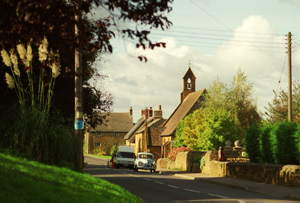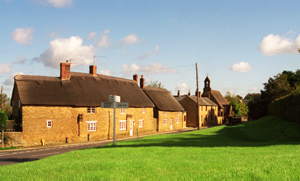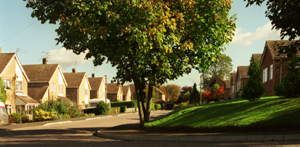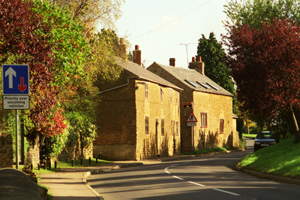Millennium Project
John Temple-Smith
 Hempton, which in Anglo-Saxon means high place, stands on a ridge 146 metres above sea level, 2.5 kilometres west of Deddington. To the north it overlooks the valley of the River Swere, whilst southwards there are unbroken fields rolling across another valley to the villages of Duns Tew and Over Worton. Westwards the road takes us towards Chipping Norton.
Hempton, which in Anglo-Saxon means high place, stands on a ridge 146 metres above sea level, 2.5 kilometres west of Deddington. To the north it overlooks the valley of the River Swere, whilst southwards there are unbroken fields rolling across another valley to the villages of Duns Tew and Over Worton. Westwards the road takes us towards Chipping Norton.
To the north and northwest of the village the traveller may see fields with a curious wave-like appearance. These are the last vestiges of the communal husbandry which flourished here in medieval times. Imagine fields, much larger than we see today, and imagine a plough so heavy and unwieldy that it had to be pulled by eight oxen. Every year each Hempton family could use this plough on the strips or 'yardlands' of the field that were theirs to cultivate. The furrows were always in the same place so that over the ages they got deeper and deeper while the ridge of soil thrown up by the blade grew higher. Thus it was that the traditional 'ridge and furrow' appearance evolved, and today, perhaps a millennium later, we can still see fields that look like a frozen undulating sea of grass.
With the Norman Conquest, Hempton came under manorial control. During the Civil War it was, alongside Deddington, a Royalist stronghold, and legend has it that King Charles spent the night in Parish's Farmhouse in Hempton's 'high street'.
* Editors note: Victoria County History (fn.148) and another source say King Charles slept at 'The Parsonage' in Deddington on the night of 1 July 1644.
 By this time most of the land in and around the village was owned by Oxford colleges, and to this day the name College Farm is to be found in more than one place. There are still one or two of the oldest inhabitants who remember how, before the First World War, tenant farmers would once a year put on their finest clothes and make their way to Christ Church in Oxford to pay their dues before dining sumptuously in Hall and having their photograph taken.
By this time most of the land in and around the village was owned by Oxford colleges, and to this day the name College Farm is to be found in more than one place. There are still one or two of the oldest inhabitants who remember how, before the First World War, tenant farmers would once a year put on their finest clothes and make their way to Christ Church in Oxford to pay their dues before dining sumptuously in Hall and having their photograph taken.
At the turn of the nineteenth century, Hempton became the subject of Parliamentary enclosure; common land disappeared and communal husbandry became extinct. For the land-owning farmers this brought new wealth and more efficient working of the land, but for the peasant farmers it brought increasing distress. In the words of William Cobbett, who saw this happening all over England, 'the houses which formerly contained little farmers and their happy families are now seen sinking into ruin'. The drift of people away from Hempton to Midland industrial towns is perhaps best illustrated by the fact that at the end of the 18th Century it had three pubs. By the time Victoria came to the throne, there was only one, the Plough, which stood at the corner of the Barford Road. But as the population of Hempton continued to decline it finally closed in the 1930s.
 Today, Hempton remains a small village, but in 1962 a new housing estate was created at St John's Way to the east of the village and north of the road to Deddington, nearly doubling the number of people in the village (see also Map of Hempton).
Today, Hempton remains a small village, but in 1962 a new housing estate was created at St John's Way to the east of the village and north of the road to Deddington, nearly doubling the number of people in the village (see also Map of Hempton).
The Church of St John the Evangelist, built in 1851 with an adjacent schoolroom was threatened with closure in the 1980s but protests from the village were too great and today it flourishes. The schoolroom is now the village hall for which kitchen and toilet facilities were recently added. Ed's note: c.f. Pevsner's History of England description
Hempton is not without its supernatural manifestations. The Hempton ghost, a relentless horseman who gallops through the village at troubled moments, has never been seen, but the thunder of his horse's hooves has been heard by countless folk over the centuries, so the tale is told.
 In 1954 Christina Hole wrote of a strange 'elemental force' on the Deddington Road, most likely to be encountered at Hempton, which causes cyclists to dismount and horses to bolt.
In 1954 Christina Hole wrote of a strange 'elemental force' on the Deddington Road, most likely to be encountered at Hempton, which causes cyclists to dismount and horses to bolt.
Further information
Hempton History - Carole Williams
Walks round the Parish - some of which include Hempton
Sources:
Ghosts and Witches of the Cotswolds, J A Brooks, 1981
Local interviews
Victoria History of the County of Oxford, Vol. XI